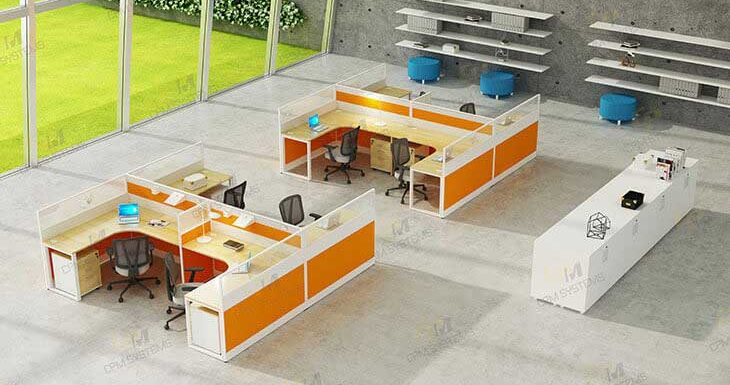The modern workplace is in constant flux. Gone are the days of the rigid, static office layout dictated by a single, predetermined design. Today’s businesses are recognizing the need for flexibility, adaptability, and a dynamic environment that fosters collaboration and innovation. This shift is driving a significant trend towards modular office furniture, which offers unparalleled customization and scalability. This article explores the compelling reasons why modular office furniture is not just a trend, but the future of workplace design.
The Rise of Adaptability: Why Modular Furniture Matters
Traditional office furniture often comes in fixed configurations, designed for a specific purpose and difficult to reconfigure. This rigidity hinders the ability to adapt to changing needs and evolving work styles. Modular furniture, however, offers a flexible solution. Components are designed to connect and rearrange, allowing for seamless transitions from individual workspaces to collaborative hubs, meeting rooms, or even temporary project zones. This adaptability is crucial in today’s dynamic business environment where companies frequently adjust their workflows and team structures.
Beyond Aesthetics: Functionality and Practicality
Modular furniture isn’t just about aesthetics; it’s about functionality. Different configurations allow companies to cater to diverse work styles. Employees who prefer focused work can create individual, enclosed zones, while collaborative teams can easily assemble open-plan spaces. The ability to tailor the workspace to individual needs boosts employee satisfaction and productivity. Moreover, modular designs often incorporate features like adjustable height desks, ergonomic chairs, and integrated storage solutions, further enhancing the practical aspects of the workspace.
Scalability and Cost-Effectiveness: Adapting to Growth
Businesses are constantly adapting to growth and change. Modular office furniture offers a significant advantage in this regard. New components can be easily added or existing ones rearranged as the company expands or downsizes. This scalability minimizes the need for costly and disruptive replacements when the workforce or project needs shift. From a financial perspective, modular furniture can often be more cost-effective in the long run. Companies can purchase only the necessary components, avoiding the overspending associated with purchasing entire, pre-designed office suites that may not fully meet evolving needs.
Environmental Sustainability: A Green Approach to Workplace Design
The environmental impact of furniture production is a growing concern. Modular furniture can contribute to a more sustainable workplace. Components are often designed to be easily disassembled, recycled, and reused, minimizing waste and promoting circularity. Furthermore, the ability to scale and adapt using existing components reduces the need for frequent replacements, lowering the overall environmental footprint compared to traditional furniture that often sits unused for extended periods. Companies seeking to reduce their carbon footprint and align with environmentally conscious practices find modular furniture a valuable asset.
Promoting Collaboration and Innovation: Fostering a Dynamic Environment
Open-plan spaces are increasingly popular, but traditional open-plan layouts can sometimes struggle with noise levels and lack of privacy. Modular furniture allows for the creation of flexible zones, creating both open and enclosed spaces within the same area. This fosters collaboration and communication while also providing the necessary focus for individual work. The dynamic nature of modular setups encourages creativity and innovation by allowing employees to easily rearrange their workspaces to suit different project needs.
Real-World Examples and Case Studies
Numerous companies have successfully implemented modular office furniture to enhance their work environments. For example, a tech startup might use modular desks and collaboration pods to quickly adapt to new team structures and project phases. A consulting firm could create easily reconfigurable meeting rooms to accommodate diverse client needs and project requirements. These examples highlight the practical application of modular furniture beyond the theoretical.
Addressing the Challenges: Considerations for Implementing Modular Furniture
While modular furniture offers numerous benefits, there are some considerations to keep in mind. The initial investment might seem higher than traditional furniture, but the long-term cost savings and adaptability often outweigh this concern. Careful planning and selection of components are crucial to ensure the furniture fits the company’s specific needs and aesthetic. It’s essential to consider factors such as the quality of materials, the longevity of the components, and the potential for future modifications.
Beyond the Office: Expanding Applications
The principles of modular design are not limited to the office setting. Modular furniture is also transforming educational environments, healthcare facilities, and even temporary workspaces. The flexibility and adaptability of modular systems make them suitable for a wide range of applications where space optimization and adaptability are paramount.
Conclusion: Embracing the Future of Workplace Design
Modular office furniture is more than just a design trend; it’s a reflection of the evolving nature of work. Its adaptability, scalability, and sustainability make it a crucial component for creating dynamic, productive, and engaging work environments. Office Workstation Manufacturer As businesses continue to adapt to the changing demands of the modern world, modular office furniture will undoubtedly play a central role in shaping the future of workplace design. By embracing this innovative approach to furniture, companies can create workspaces that are not only aesthetically pleasing but also highly functional, adaptable, and environmentally conscious.

*
*